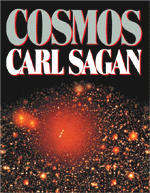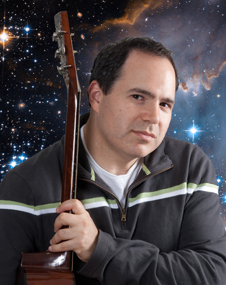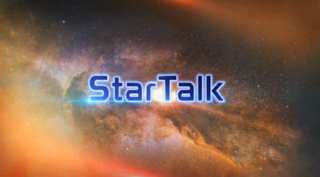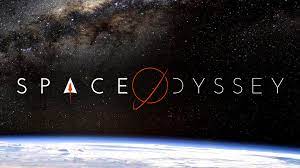
Astrophysics is a science that employs the methods and principles of physics and chemistry in the study of astronomical objects and phenomena. As one of the founders of the discipline, James Keeler, said, astrophysics "seeks to ascertain the nature of the heavenly bodies, rather than their positions or motions in space–what they are, rather than where they are", which is studied in celestial mechanics.

Neil deGrasse Tyson is an American astrophysicist, author, and science communicator. Tyson studied at Harvard University, the University of Texas at Austin, and Columbia University. From 1991 to 1994, he was a postdoctoral research associate at Princeton University. In 1994, he joined the Hayden Planetarium as a staff scientist and the Princeton faculty as a visiting research scientist and lecturer. In 1996, he became director of the planetarium and oversaw its $210 million reconstruction project, which was completed in 2000. Since 1996, he has been the director of the Hayden Planetarium at the Rose Center for Earth and Space in New York City. The center is part of the American Museum of Natural History, where Tyson founded the Department of Astrophysics in 1997 and has been a research associate in the department since 2003.

Marcelo Gleiser is a Brazilian physicist and astronomer. He is a professor of physics and astronomy at Dartmouth College.

Cosmos is a popular science book written by astronomer and Pulitzer Prize-winning author Carl Sagan. It was published in 1980 as a companion piece to the PBS mini-series Cosmos: A Personal Voyage with which it was co-developed and intended to complement. Each of the book's 13 illustrated chapters corresponds to one of the 13 episodes of the television series. Just a few of the ideas explored in Cosmos include the history and mutual development of science and civilization, the nature of the Universe, human and robotic space exploration, the inner workings of the cell and the DNA that controls it, and the dangers and future implications of nuclear war. One of Sagan's main purposes for both the book and the television series was to explain complex scientific ideas in a way that anyone interested in learning can understand. Sagan also believed the television was one of the greatest teaching tools ever invented, so he wished to capitalize on his chance to educate the world. Spurred in part by the popularity of the TV series, Cosmos spent 50 weeks on the Publishers Weekly best-sellers list and 70 weeks on the New York Times Best Seller list to become the best-selling science book ever published at the time. In 1981, it received the Hugo Award for Best Non-Fiction Book. The unprecedented success of Cosmos ushered in a dramatic increase in visibility for science-themed literature. The success of the book also served to jumpstart Sagan's literary career. The sequel to Cosmos is Pale Blue Dot: A Vision of the Human Future in Space (1994).

Manhattanhenge, also called the Manhattan Solstice, is an event during which the setting sun or the rising sun is aligned with the east–west streets of the main street grid of Manhattan, New York City. The astrophysicist Neil deGrasse Tyson claims to have coined the term, by analogy with Stonehenge. The sunsets and sunrises each align twice a year, on dates evenly spaced around the summer solstice and winter solstice. The sunset alignments occur around May 28 and July 13. The sunrise alignments occur around December 5 and January 8.

Marc Kuchner is an American astrophysicist, and the Citizen Science Officer at NASA Headquarters. He is known for his work on citizen science, and imaging of disks and exoplanets. Together with Wesley Traub, he invented the band-limited coronagraph, used on the James Webb Space Telescope (JWST), originally designed for the proposed Terrestrial Planet Finder (TPF) telescope. He is also known for his novel supercomputer models of planet-disk interactions and for developing the ideas of ocean planets, carbon planets, and helium planets. Kuchner appears as an expert commentator in the National Geographic television show "Alien Earths" and frequently answers the "Ask Astro" questions in Astronomy Magazine. Kuchner helped found several citizen science projects, including Disk Detective and Backyard Worlds.

Nova ScienceNow is a spinoff of the long-running and venerable PBS science program Nova. Premiering on January 25, 2005, the series was originally hosted by Robert Krulwich, who described it as an experiment in coverage of "breaking science, science that's right out of the lab, science that sometimes bumps up against politics, art, culture". At the beginning of season two, Neil deGrasse Tyson replaced Krulwich as the show's host. Tyson announced he would leave the show and was replaced by David Pogue in season 6.

Adam Frank is an American physicist, astronomer, and writer. His scientific research has focused on computational astrophysics with an emphasis on star formation and late stages of stellar evolution. His work includes studies of exoplanet atmospheres and astrobiology. The latter include studies of the generic response of planets to the evolution of energy-intensive civilizations (exo-civilizations).

Cosmos: A Spacetime Odyssey is a 2014 American science documentary television series. The show is a follow-up to the 1980 television series Cosmos: A Personal Voyage, which was presented by Carl Sagan on the Public Broadcasting Service and is considered a milestone for scientific documentaries. This series was developed to bring back the foundation of science to network television at the height of other scientific-based television series and films. The show is presented by astrophysicist Neil deGrasse Tyson, who, as a young high school student, was inspired by Sagan. Among the executive producers are Seth MacFarlane, whose financial investment was instrumental in bringing the show to broadcast television, and Ann Druyan, a co-author and co-creator of the original television series and Sagan's wife. The show is produced by Brannon Braga, and Alan Silvestri composed the score.

Space Chronicles: Facing the Ultimate Frontier is the 2012 anthology by Neil deGrasse Tyson covering his various writings relating to the history and future of NASA and space travel in general.
"Standing Up in the Milky Way" is the first aired episode of the American documentary television series Cosmos: A Spacetime Odyssey. It premiered on March 9, 2014, simultaneously on various Fox television networks, including National Geographic Channel, FX, Fox Life, and others. The episode is presented by the series host astrophysicist Neil deGrasse Tyson, directed by Brannon Braga, produced by Livia Hanich and Steven Holtzman, and written by Ann Druyan and Steven Soter.

StarTalk is a podcast on science, comedy, and popular culture hosted by astrophysicist Neil deGrasse Tyson and comedian Chuck Nice, with various other comic and celebrity co-hosts and frequent guests from the worlds of science and entertainment. Past co-hosts have included Colin Jost, Lynne Koplitz, Leighann Lord, Eugene Mirman, John Oliver, and Kristen Schaal. Guests have included astronaut Buzz Aldrin, actor Morgan Freeman, George Takei, comedian Joan Rivers, Arianna Huffington, YouTuber Sam Denby, Richard Dawkins and writer Mary Roach. StarTalk has a segment called Cosmic Queries, in which listeners send in questions about the universe to be answered on the show.
Startalk or StarTalk may refer to:

StarTalk is an American television talk show hosted by Neil deGrasse Tyson that aired weekly on National Geographic. StarTalk is a spin-off of the podcast of the same name, in which Tyson discusses scientific topics through one-on-one interviews and panel discussions. Space.com called it the "first-ever science-themed late-night talk show." The series premiered on April 20, 2015.

Welcome to the Universe: An Astrophysical Tour is a popular science book by Neil deGrasse Tyson, Michael A. Strauss, and J. Richard Gott, based on an introductory astrophysics course they co-taught at Princeton University. The book was published by the Princeton University Press on September 20, 2016.

Astrophysics for People in a Hurry is a 2017 popular science book by Neil deGrasse Tyson, centering around a number of basic questions about the universe. Published on May 2, 2017, by W. W. Norton & Company, the book is a collection of Tyson's essays that appeared in Natural History magazine at various times from 1997 to 2007.

Space Odyssey: The Video Game is an upcoming sandbox video game with 4X elements developed by Space Media Ventures for Microsoft Windows, macOS, Linux, iOS, and Android systems, including virtual reality devices. The game is being co-developed by astrophysicist Neil deGrasse Tyson, and has some educational aspects as the player designs and grows parts of a virtual galaxy.
Matthew John O'Dowd is an Australian astrophysicist. He is an associate professor in the Physics and Astronomy Department at the Lehman College of the City University of New York and writer and host of PBS Space Time on YouTube. He is a frequent guest on Science Goes to the Movies on CUNY TV and on StarTalk radio with Neil deGrasse Tyson.

Cosmos: Possible Worlds is a 2020 American science documentary television series that premiered on March 9, 2020, on National Geographic. The series is a follow-up to the 2014 television series Cosmos: A Spacetime Odyssey, which followed the original Cosmos: A Personal Voyage series presented by Carl Sagan on PBS in 1980. The series is presented by astrophysicist Neil deGrasse Tyson, written, directed, and executive-produced by Ann Druyan and Brannon Braga, with other executive producers being Seth MacFarlane and Jason Clark.

Charles Tsun-Chu Liu is a Taiwanese-born American astronomer and astronomy educator. His research interests include merging and colliding galaxies, active galactic nuclei, and the star formation history of the universe. He is a former director of the William E. Macaulay Honors College and The Verrazano School at the City University of New York's College of Staten Island. He currently serves as a professor of physics and astronomy at the College of Staten Island, and as President of the Astronomical Society of New York. Liu is the 2024 winner of the American Astronomical Society's (AAS) prestigious Education Prize, and was named an AAS fellow in 2019.


















